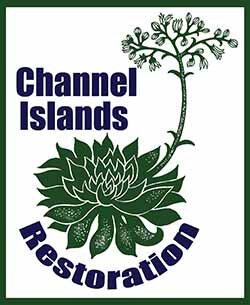1,100 plants have been grown at the nursery on
San Nicolas Island so far
Channel Islands Restoration staff and volunteers teamed up with the United States Navy in April on San Nicholas Island to completely rebuild and expand an old native plant nursery.
More than 1,100 plants have been grown so far, and CIR staff and volunteers recently planted most of these at a restoration site on the island.
The nursery, which consisted of a shed and small planting benches, had fallen into disrepair over nearly two decades.
CIR built new benches, erected a shade structure and installed an irrigation system.
The three benches (each forty feet long and six feet wide) include custom designed “biosecurity” measures that prevent introduced pests like Argentine ants from infesting the plant pots.
The nursery shed required major cleaning, and it will soon receive repairs to its roof and doors.
Funding to build the new nursery and to grow the plants has been provided by the Navy.
The nursery has an automated irrigation system, so CIR staff only needs to visit the island approximately once per week.
The plants were installed at a restoration site on the eastern side of the island to help prevent erosion along roadside dune habitat.
More plants will be grown in the nursery to revegetate sites impacted by upcoming construction projects on the island.
CIR Board Member Gordon Hart designed the nursery and led the construction project along with volunteers Dave Edwards (also a Board Member) Don Mills and John Reyes.
The plants were grown by Norma Hogan, who recently joined the CIR team.


































